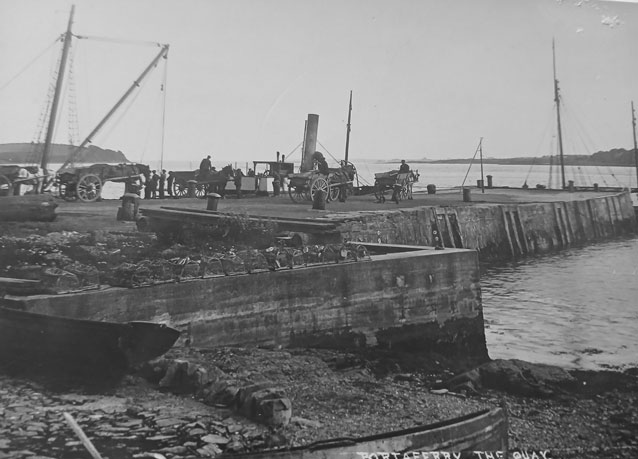On 12 September Bangor Historical Society welcomed Allison Murphy to give the opening talk of the 2024-25 season. Her subject was ‘Sailing Ships and Sea Captains’ of Portaferry. Our chairman welcomed her and also told the audience that the committee were considering the marking of the society’s 50th anniversary in 2026.
Allison began by outlining something of Portaferry’s early history. It lies in the Upper Ards less than a mile from Strangford at the entrance to the largest sea inlet in the British Isles. St. Patrick was among those who came to the area. It was the Vikings who gave the name Strangford to the Lough which had been formerly known as Lough Cuan. Two Viking kings were killed in the neighbourhood. Next to arrive were the Normans. William Le Savage accompanied John de Courcy to Ulster in the late 12th century. He became the most prominent landowner in the area and his descendants stayed there for the next 700 years.
Throughout the Middle Ages Portaferry remained a small village with little trade and only fisherman’s cottages. In 1629 an official ferry across the mouth of the lough was set up and a report of 1637 confirms that the Savages took the customs.
In 1623 Patrick Savage married Jane the daughter of Hugh Montgomery of Greyabbey. The Savages were in debt, but Hugh resolved to help his new son-in-law. He sent the newly married couple to the Isle of Man for 2 years. Then he ordered his second son to develop Portaferry while they were away by increasing trading, building houses etc. By the mid-eighteenth century Portaferry was a thriving town, even sending goods to Chester Fair. A plan of the town in 1779 shows a market house, a brewery and the house and demesne of the Savages. The layout was similar to the present one and the plan also showed the old castle and the town parks.

By the late eighteenth century ship building had also become important. By 1802 the biggest ship in Ireland had been launched. It was the ‘Bess’ of 500 tons, the property of George Matthews of Springvale and Captain Downey of Portaferry. Allison then went on to talk about some of the prominent shipbuilders and sea captains from the area. Thomas Gelston, born in 1769 came from the Gransha, outside Portaferry. He was a sea captain who set up a ship building firm in Portaferry in 1791. His business flourished and among those he built was the ‘Andrew Savage’. In 1823 he went bankrupt. He had lost money on the ‘Aurora’ whose crew got very drunk and scuttled the ship off the west coast of Ireland.
Another prominent ship captain and owner was Captain James Pollock. Emigration also took place from Portaferry. Captain Pollock was the subject of a letter in the Montreal Herald signed by 43 passengers and thanking him for a good voyage. Another sea captain of the early nineteenth century was William McCleery, a ship owner and merchant. He named ships after his daughters.
In 1822/3 the head of the Savage family was left money and an estate, provided he changed his surname to Nugent and also his religion. He complied. In 1826 the ship ‘Andrew Nugent’ was launched. In 1839 it was wrecked in a hurricane off Donegal. Among the victims was the captain, Hugh Crangle. The Rev John Orr, the local Presbyterian minister, had written about the launch of the ship. He had also raised money to build the church now known as the Portico.
By the mid 1830s the town was still growing. Some gentlemen’s residences were built along the shore. A steam ferry now connected the village to Strangford. It was the first steam ferry in Ireland. John and James Maxwell were partners in the steamboat company. Their ferry was called the ‘Lady of the Lake’. Later shipbuilding declined, but trade continued to grow: ships carried coal, potatoes, wheat and pig iron around the Irish Sea. Another aspect of industry was ship salvage.
The 1911 census shows that many of the men from the area were sailors. During the First World War some enlisted in the Royal Navy. The speaker listed the names of those who were killed. Among them was Hugh Francis McNally, a surgeon, who was with Lord Kitchener on board the HMS Hampshire when it sank due to enemy action.
Allison’s enthusiasm for Portaferry and its history was clear and the chairman, Ian Wilson, congratulated her on an excellent talk. The next meeting will take place on Thursday 10th October at 8pm in the Fountain Centre on Queen’s Parade. Peter Gibson of the ‘Discover Groomsport’ group will give a talk. Visitors are welcome to join members for a small fee.
